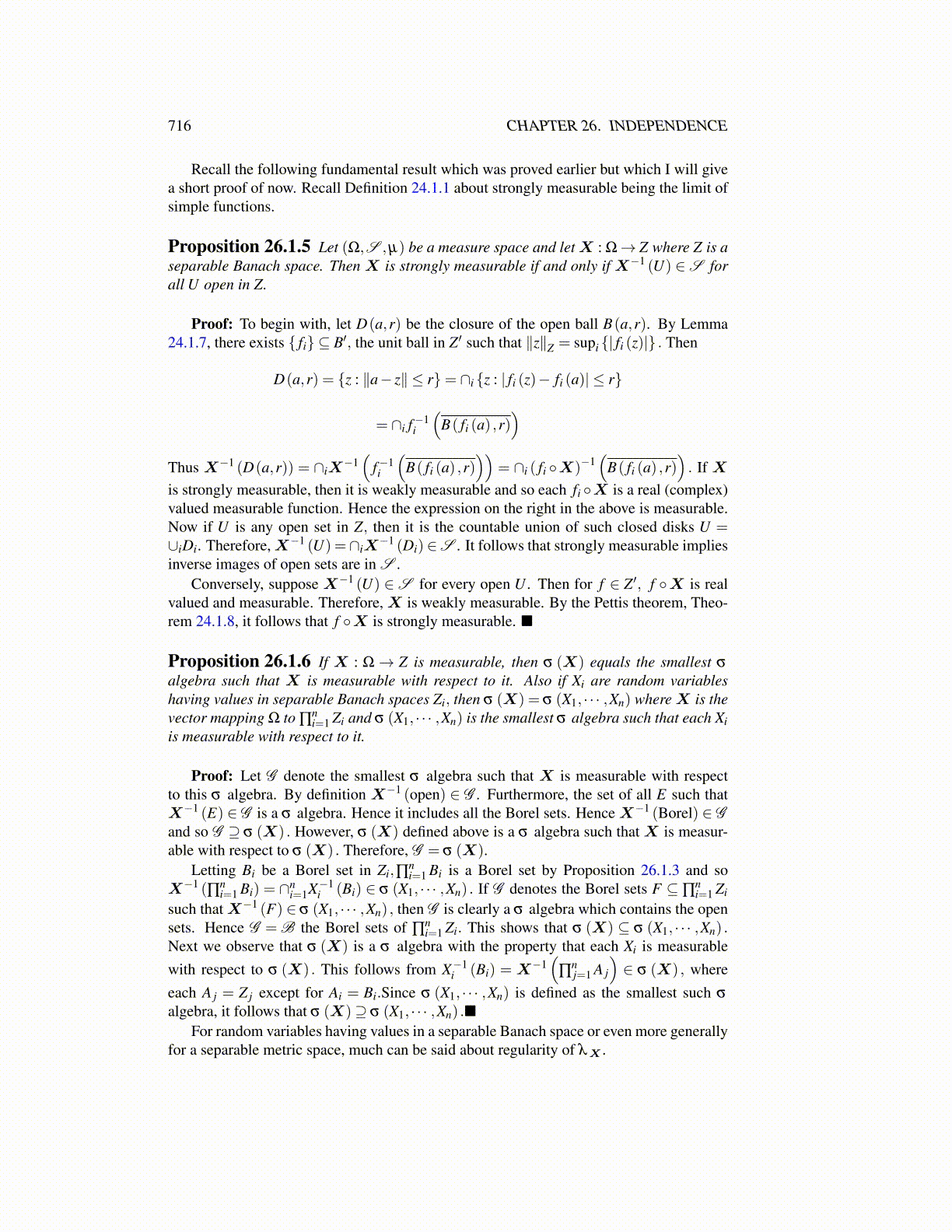
716 CHAPTER 26. INDEPENDENCE
Recall the following fundamental result which was proved earlier but which I will givea short proof of now. Recall Definition 24.1.1 about strongly measurable being the limit ofsimple functions.
Proposition 26.1.5 Let (Ω,S ,µ) be a measure space and letX : Ω→ Z where Z is aseparable Banach space. Then X is strongly measurable if and only if X−1 (U) ∈S forall U open in Z.
Proof: To begin with, let D(a,r) be the closure of the open ball B(a,r). By Lemma24.1.7, there exists { fi} ⊆ B′, the unit ball in Z′ such that ∥z∥Z = supi {| fi (z)|} . Then
D(a,r) = {z : ∥a− z∥ ≤ r}= ∩i {z : | fi (z)− fi (a)| ≤ r}
= ∩i f−1i
(B( fi (a) ,r)
)Thus X−1 (D(a,r)) = ∩iX
−1(
f−1i
(B( fi (a) ,r)
))= ∩i ( fi ◦X)−1
(B( fi (a) ,r)
). If X
is strongly measurable, then it is weakly measurable and so each fi ◦X is a real (complex)valued measurable function. Hence the expression on the right in the above is measurable.Now if U is any open set in Z, then it is the countable union of such closed disks U =∪iDi. Therefore,X−1 (U) =∩iX
−1 (Di)∈S . It follows that strongly measurable impliesinverse images of open sets are in S .
Conversely, suppose X−1 (U) ∈S for every open U . Then for f ∈ Z′, f ◦X is realvalued and measurable. Therefore,X is weakly measurable. By the Pettis theorem, Theo-rem 24.1.8, it follows that f ◦X is strongly measurable. ■
Proposition 26.1.6 If X : Ω→ Z is measurable, then σ (X) equals the smallest σ
algebra such that X is measurable with respect to it. Also if Xi are random variableshaving values in separable Banach spaces Zi, then σ (X) = σ (X1, · · · ,Xn) whereX is thevector mapping Ω to ∏
ni=1 Zi and σ (X1, · · · ,Xn) is the smallest σ algebra such that each Xi
is measurable with respect to it.
Proof: Let G denote the smallest σ algebra such that X is measurable with respectto this σ algebra. By definition X−1 (open) ∈ G . Furthermore, the set of all E such thatX−1 (E) ∈ G is a σ algebra. Hence it includes all the Borel sets. Hence X−1 (Borel) ∈ Gand so G ⊇ σ (X) . However, σ (X) defined above is a σ algebra such that X is measur-able with respect to σ (X) . Therefore, G = σ (X).
Letting Bi be a Borel set in Zi,∏ni=1 Bi is a Borel set by Proposition 26.1.3 and so
X−1 (∏ni=1 Bi) = ∩n
i=1X−1i (Bi) ∈ σ (X1, · · · ,Xn) . If G denotes the Borel sets F ⊆∏
ni=1 Zi
such thatX−1 (F) ∈ σ (X1, · · · ,Xn) , then G is clearly a σ algebra which contains the opensets. Hence G = B the Borel sets of ∏
ni=1 Zi. This shows that σ (X) ⊆ σ (X1, · · · ,Xn) .
Next we observe that σ (X) is a σ algebra with the property that each Xi is measurablewith respect to σ (X) . This follows from X−1
i (Bi) = X−1(
∏nj=1 A j
)∈ σ (X) , where
each A j = Z j except for Ai = Bi.Since σ (X1, · · · ,Xn) is defined as the smallest such σ
algebra, it follows that σ (X)⊇ σ (X1, · · · ,Xn) .■For random variables having values in a separable Banach space or even more generally
for a separable metric space, much can be said about regularity of λX .